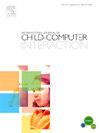Supporting and understanding autistic children’s non-verbal interactions through OSMoSIS, a motion-based sonic system
Q1 Social Sciences
International Journal of Child-Computer Interaction
Pub Date : 2025-02-16
DOI:10.1016/j.ijcci.2025.100726
引用次数: 0
Abstract
Music therapy for autistic children focuses on supporting motor and social interaction through creative movement and musical activities. Previous research suggests it can further support the development of underlying skills related to non-verbal communication, namely social motor synchrony and imitation. Motion-sensing technology in this context has the potential to both support children’s engagement in therapy and help researchers understand its impact. We describe and evaluate a system, OSMoSIS, which aims to provide support by generating sounds based on children’s movements. An evaluation through two empirical studies shows (1) higher levels of imitation and interactional synchrony when using the system compared with motor-only activities and (2) that children found the interaction enjoyable, showing more instances of positive affect when the system was activated with the sounds on. We discuss how the findings highlight new directions for further research on technology for music therapy and have the potential to support practitioners and families.
通过OSMoSIS(一种基于动作的声音系统)来支持和理解自闭症儿童的非语言互动
自闭症儿童的音乐治疗侧重于通过创造性的运动和音乐活动来支持运动和社会互动。先前的研究表明,它可以进一步支持与非语言交流相关的潜在技能的发展,即社会运动同步和模仿。在这种情况下,动作感应技术有可能支持儿童参与治疗,并帮助研究人员了解其影响。我们描述并评估了一个系统,OSMoSIS,它旨在通过根据儿童的运动产生声音来提供支持。通过两项实证研究进行的评估显示:(1)使用该系统时,孩子们的模仿水平和互动同步性比只使用运动的活动高;(2)当系统打开时,孩子们发现互动很愉快,表现出更多的积极影响。我们讨论了这些发现如何突出了音乐治疗技术进一步研究的新方向,并有可能为从业者和家庭提供支持。
本文章由计算机程序翻译,如有差异,请以英文原文为准。
求助全文
约1分钟内获得全文
求助全文
来源期刊

International Journal of Child-Computer Interaction
Social Sciences-Education
CiteScore
7.20
自引率
0.00%
发文量
73
 求助内容:
求助内容: 应助结果提醒方式:
应助结果提醒方式:


